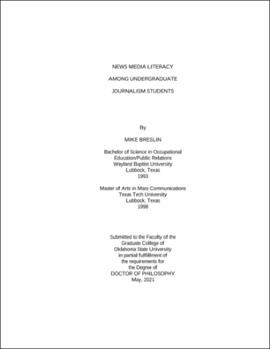| dc.contributor.advisor | Wanger, Stephen | |
| dc.contributor.author | Breslin, Mike | |
| dc.date.accessioned | 2021-09-23T19:42:43Z | |
| dc.date.available | 2021-09-23T19:42:43Z | |
| dc.date.issued | 2021-05 | |
| dc.identifier.uri | https://hdl.handle.net/11244/330837 | |
| dc.description.abstract | Like most young people, university students are adept in their use of communication technologies such as smartphones and apps. However, this technological savvy does not necessarily translate into news media literacy (NML), which "refers to the knowledge and motivations needed to identify and engage with journalism" (Maksl et al., 2015, p. 29). As such, a better understanding of news media literacy among undergraduates and the factors that impact that literacy is needed. However, there is a lack of scholarship that examines the NML levels among college students. This lack is especially pronounced with regard to undergraduates who are majoring in journalism-related disciplines. As these are the students who are most likely to become news media professionals, and thus the providers of the news media content consumed by their fellow citizens, an examination of their NML levels is particularly warranted. | |
| dc.description.abstract | This study explored the news media literacy levels of undergraduate students at two central U.S. universities using a quantitative survey. A key focus of this study was an examination of the NML levels of students in journalism and journalism-related programs to determine if differences in their respective news media literacy levels could be identified. The results indicated that there were such differences. After placing all survey participants in a high or low news media literacy cluster based on their responses to several measures, journalism students placed in the high news media literacy group 25% more often than non-journalism majors. In addition, journalism students displayed significantly less skepticism regarding news media content that other students. Finally, a relationship was observed between placement in the higher news media literacy cluster and various demographic factors such as age and ethnicity. | |
| dc.description.abstract | Although a number of study limitations should be kept in mind, these results suggest that: | |
| dc.description.abstract | 1. The need for news media literacy interventions may be greater among marginalized students. | |
| dc.description.abstract | 2. Given the seeming disconnect between low news media skepticism levels among journalism majors vs. public trust levels in news media that are consistently low, journalism educators need to re-examine how their curricula address this gap. | |
| dc.format | application/pdf | |
| dc.language | en_US | |
| dc.rights | Copyright is held by the author who has granted the Oklahoma State University Library the non-exclusive right to share this material in its institutional repository. Contact Digital Library Services at lib-dls@okstate.edu or 405-744-9161 for the permission policy on the use, reproduction or distribution of this material. | |
| dc.title | News media literacy among undergraduate journalism students | |
| dc.contributor.committeeMember | Cole, Ki Lynn | |
| dc.contributor.committeeMember | Manning-Ouellette, Amber | |
| dc.contributor.committeeMember | Senat, Joey | |
| osu.filename | Breslin_okstate_0664D_17085.pdf | |
| osu.accesstype | Open Access | |
| dc.type.genre | Dissertation | |
| dc.type.material | Text | |
| dc.subject.keywords | communications | |
| dc.subject.keywords | journalism | |
| dc.subject.keywords | media | |
| dc.subject.keywords | media literacy | |
| dc.subject.keywords | news literacy | |
| dc.subject.keywords | news media literacy | |
| thesis.degree.discipline | Educational Leadership and Policy Studies | |
| thesis.degree.grantor | Oklahoma State University | |
